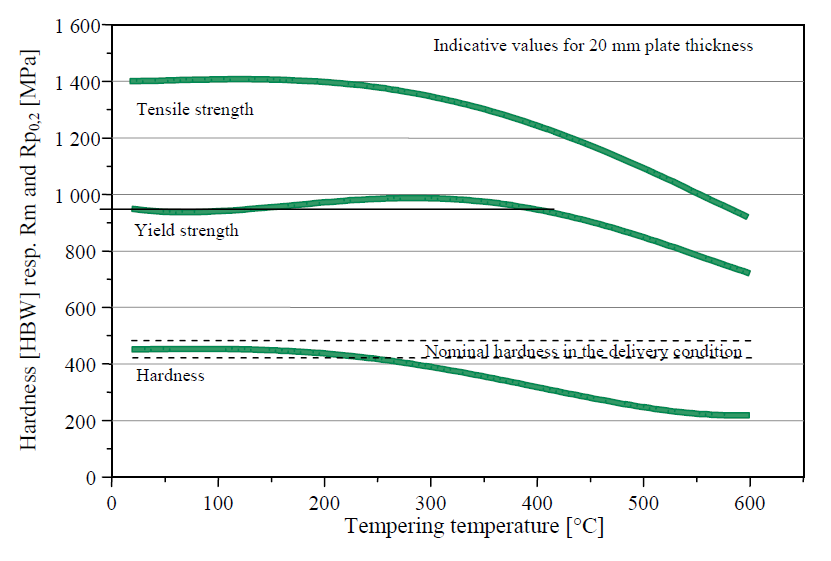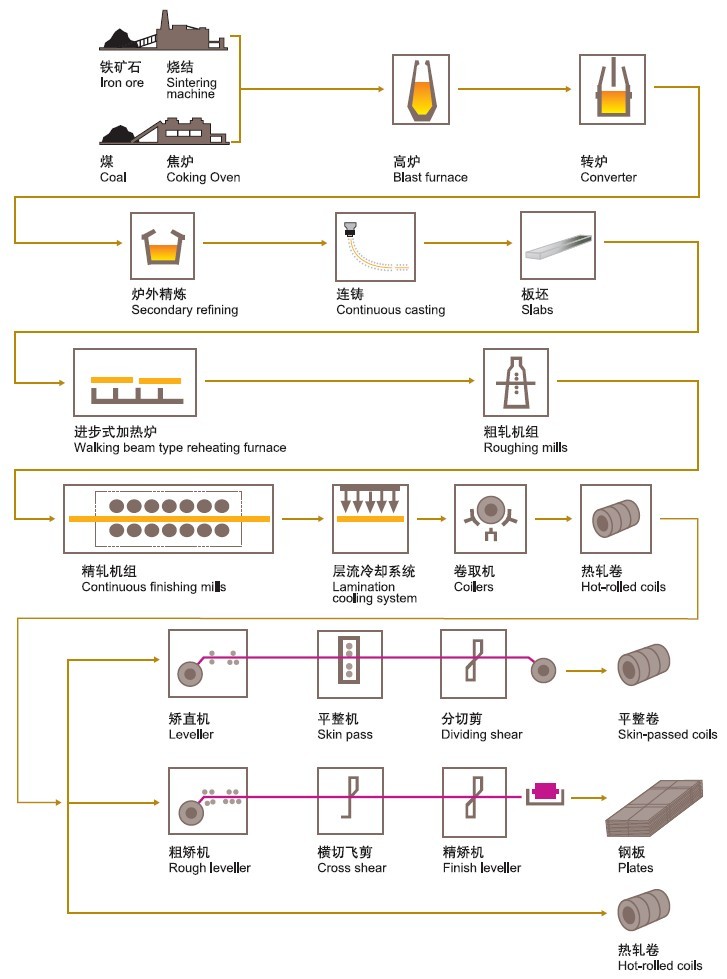Suzhou Vanforge Metals Co., Ltd. |
|
450HBW quenched fine grain wear resistant structural steel plate
450HBW QUENCHED WEAR RESISTANT STEEL is a wear resistant steel with a nominal hardness of 450 HBW in delivery condition ex works.
450HBW QUENCHED WEAR RESISTANT STEEL is preferentially used by the customers where elevated resistance to wear is required together with good workability and especially good weldability.
Examples of application: earth moving and loading machines, dredgers, skip cars, conveying plants, trucks, cutting edges, knives and breakers, waste elimination and recycling plants.
Product description
Range of application
450HBW QUENCHED WEAR RESISTANT STEEL can be delivered in thicknesses from 8 mm (1/3 in.) to 100 mm (4 in.), according to the dimensional program. Other dimensions may be possible on request.
Chemical composition
For the ladle analysis, the following limiting values in % are applicable, max.:
| C | Si | Mn | P | S |
| 0.25 | 0.70 | 1.60 | 0.025 | 0.010 |
Depending on thickness, the following alloying elements may be used singly or in combination, max.:
| Mo | Ni | Cu | Cr | V | Nb | B |
| 0.50 | 0.80 | 0.30 | 1.50 | 0.08 | 0.05 | 0.005 |
The steel is fully killed and fine grain treated.
Delivery condition
Controlled water quenched.
Mechanical properties in the delivery condition
Hardness
Brinell surface hardness at room temperature: 420 - 480 HBW
Tensile testing on transverse specimens at room temperature (indicative values for 20 mm plate thickness)
Tensile strength: 1400 MPa (203 ksi)3
Yield point: 950 MPa (138 ksi)3
Elongation: 11 % (Lo = 5.65·√So)
In spite of their high tensile properties, VANFORGE steels are not intended for safety relevant components. For this purpose high strength steels are available.
Charpy-V impact test on longitudinal specimens (indicative values for 20 mm plate thickness)
Charpy impact energy: 35 J at -20 °C (-4 °F)
Testing
Brinell surface hardness tested once per heat and 40 t.
Identification of plates
Unless otherwise agreed the marking is carried out via steel stamps with at least the following information:
Processing
The entire processing and application techniques are of fundamental importance to the reliability of the products made from this steel. The user should ensure that his design, construction and processing methods are aligned with the material, correspond to the state of the art that the fabricator has to comply with and are suitable for the intended use. The customer is responsible for the selection of the material. The recommendations in accordance with EN 1011-2 (Welding) and CEN/TR 10347 (Forming) as well as recommendations regarding job safety in accordance with national rules should be observed while considering
the higher strength and hardenability.
Cold forming
450HBW QUENCHED WEAR RESISTANT STEEL can be cold formed by bending in spite of its high hardness and strength. It should be paid attention to the fact that with increasing yield strength the required forces for the forming operation also increase, even if the plate thickness remains unchanged. The spring-back also increases. In order to avoid the risk of cracking from the edges, flame cut or sheared edges should be ground in the area that is to be cold formed. It is also advisable to round the plate edge slightly on the outside of the bend coming under tension stress during bending.
During the processing, the necessary safety measures have to be taken, so that nobody will be exposed to a danger by a possible fracture of the work piece during the forming process.
The following geometries can usually be achieved by cold forming without the formation of surface defects
(where t is the plate thickness):
| Minimum bending radius | Minimum die width | |
| Transverse direction | 5 t | 14 t |
| Longitudinal direction | 6 t | 16 t |
Hot forming
Since 450HBW QUENCHED WEAR RESISTANT STEEL obtains its hardness by accelerated cooling from the austenitizing temperature, hot forming without major hardness loss is only possible if a renewed quenching treatment is carried out after forming. However, the hardness achieved through such a treatment may differ from that measured in the delivery condition. This is due to the fact that the cooling conditions at the fabricator’s works are generally less
effective than those available during plate production.
The steel can be heated to about 200 °C (390 °F) without any substantial drop in hardness 250 °C (482 °F) for short period).
Flame cutting and welding
For flame cutting, the following minimum temperatures should be observed: 50 °C (122 °F) for plate thicknesses up to 26 mm, 100 °C (212 °F) for plate thicknesses from 26 up to 52 mm, and 125 °C (257 °F) for thicker plates.
For manual arc welding basic coated rods, having a very low residual moisture should be used (if necessary, drying according to the instruction of the manufacturer should be carried out).
Additionally the following recommendations are to be considered:
Heat treatment
The following diagram shows the general changes in hardness or strength values in accordance with the heat treatment temperature:

Machining
450HBW QUENCHED WEAR RESISTANT STEEL can be machined with HSS-drills and especially with HSS-Co-alloyed drills with a satisfactory service life if the drill advance and cutting speed are correspondingly accommodated.
General technical delivery requirements
Unless otherwise agreed, the general technical requirements in accordance with EN 10021 are applicable.
Tolerances
Unless otherwise agreed, the tolerances are in accordance with EN 10029, with class A for thickness.
Surface quality
Unless otherwise agreed, the provisions in accordance with EN 10163-2, class A2 are applicable.
General note
If special requirements, which are not covered in this material data sheet, are to be met by the steel due to its intended use or processing, these requirements are to be agreed before placing the order.
Production process
